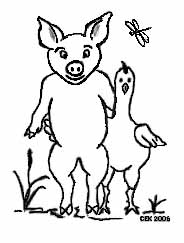
|
|

|
|
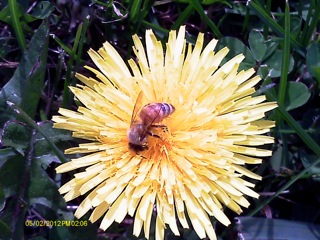
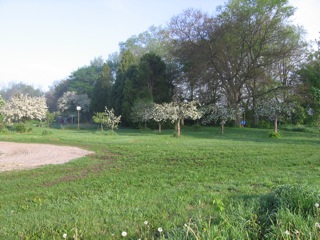
|
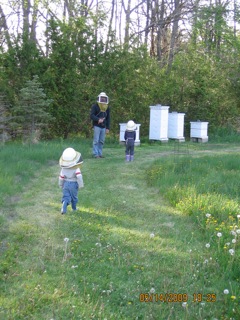
Our bees have access to a variety of flowers around our yard and farm. In our yard we have flowers, crabapple trees, a locust, a silver maple, a basswood, hackberries, mulberries, fruit trees, currants, gooseberries, strawberries, raspberries, dandelions, and clover. We have also worked hard to get wildflowers to once again grow in the grassy verges that border our fields, so the bees enjoy milkweed, wild geraniums, and profusions of golden rods and asters in late summer and fall. |
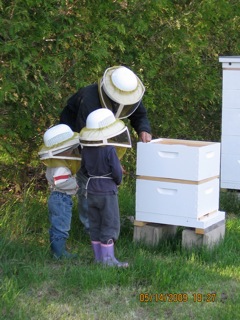
There are, of course, far too many plants to mention them all. Suffice it to say that our honey is made from a diversity of flowering plants, making it highly flavorful. If you're a honey connoisseur, you've got to try it. If not, you may find you become one after trying it.
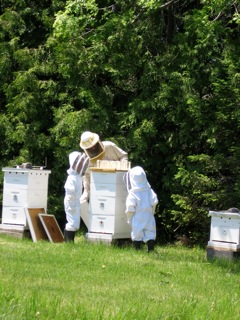
On wearing them for the first time, the youngest said to the bees "Bees, you're wasting your time. I'm bee-proof!" |
Bees everywhere face challenges, ours included. In the winter of 2010-11, we lost all our hives due to high levels of radiofrequency (RF) radiation radiating from the utility transformer in our yard. When we went off-grid, that was removed. In the winter of 2011-2012 we lost only one small hive. Over the next year, as utilization of wireless technology grew, pulsed microwave radiation levels (used by wireless devices to communicate) have increased dramatically (simple steps to help bees). By fall of 2012, one of our largest most vigorous hives was empty. By December 2012, all hives but one had died. In January 2013, we lost the last one. In fall of 2013, after a good summer season with new packages of bees we began losing hives. We lost two before winter really even set in for no reason that we could tell.
In January 2014, we had five living hives, but then we started losing them and only one made it to spring. We got three new packages in spring to go with the one weak hive and it was a good thing we did since the weak hive was empty by July. So, we again started with new hives in 2014. They performed well through the year. In late fall 2014, we moved the hives into our machine shed where RF/microwave radiation levels are significantly lower. All three made it through the winter and we moved them outside in spring of 2015. Then we had a cold rainy week and the two large hives went through their remaining food faster than they should have and died.
In spring 2015, we built a shielded bee house which we located carefully to minimize exposure to wireless radiation. We got three nucs and four packages in addition to the remaining hive. We located four hives in the bee house and 4 hives outside to see if it made a difference. In the beginning of October we had six hives, three shielded and three unshielded. By December 17, 2015, all but one inside hive were dead and we lost it shortly after.
In spring 2016, we got two nucs and put both inside. We had one swarm, but caught it in an old hive. It and the unswarmed hive have survived. Only the inside hive made enough honey to harvest. We lost both hives in the fall of 2016 before the worst of the winter set in.
Since 4G cell service was installed in our area, the only time the bees made it through the winter was when we put them in the unheated machine shed, a steel pole shed with excellent shielding properties. So, then we built them their own shielded bee house. We hoped that would protect them through the winter without having to move them. They didn't make it. Last year we left them in the shielded bee house until Dan was done with field work. The fall was reasonably mild up until then so we hoped it would be okay. Unfortunately, by the time we moved them, the clusters were so small that they could not make it through the winter. We think that they get lost on their cleansing flights and with reproduction essentially stopped the losses are ultimately lethal to the colony. With the winter cold any delay in return to the hive can be fatal. Radiation from wireless devices has been shown to disorient bees. Please read BEES, BIRDS AND MANKIND: Destroying nature by "electrosmog", a good report on the detrimental effects that radiation from wireless technology has on bees. While the bees were in the machine shed, we noticed great drifts of dead bees outside the machine shed exits. It was unclear if it was the cold or the wireless radiation that killed them just outside the shed.
We got our 2017 new package bees in late April. We got three hives. They were doing well in their newly modified shielded bee house, however none of them survived the winter. Since then, none of our bees have survived the winter no matter what we have tried. Frequently, the bees are dead by late fall.
Several factors seem to cause the mortality. They use food stores too fast and starve. We feed them in the winter in addition to leaving them honey, but what used to be an adequate WINTER supply of honey now only lasts a couple of months at best. Sometimes they also just don't move out from the center cluster enough to eat available food and starve. If the cluster gets too small it will freeze and die. It seems as though this happens because they simply lose too many bees on cleansing flights and can't keep warm enough anymore and so die. For those who don't know, bees need to fly out of the hive in the winter to poop. This is where radiation from wireless technology causes them huge problems by disorienting their navigation. They go out and never come back. Winter flying is rough enough anyway and any additional time spent orienting is likely to be a matter of life and death. We think that is why the machine shed worked better than the shielded bee house. When they are in the machine shed, they can make their cleansing flight without ever leaving the protected low-RF environment. In the bee house, the hive is protected, but they fly straight outside. Finally, wireless radiation impairs the immune system in humans and likely does so in bees, making them more susceptible to variety of diseases that wear down their health and vitality and contribute to hive mortality.
If you want to know more about the problem that we think has been killing our bees and now our trees too, read below. It is very important because it can affect your health too.
We will try to the best of our ability to protect our bees from the radiofrequency radiation increasingly pervading the world. We do not live under a tower. The closest is over a mile away, but use of wireless devices has soared, resulting in large increases in ambient radiation. A recent study by the EMRadiation Policy Institute has shown that many antennas are out of compliance with even the FCC's outdated thermally-based radiofrequency radiation limits. This has been confirmed by a Wall Street Journal investigation "Cellphone Boom Spurs Antenna-Safety Worries Many Sites Violate Rules Aimed at Protecting Workers From Excessive Radio-Frequency Radiation" which found that one in ten antenna sites are out of compliance. The article discusses the danger to various workers who are unaware of the dangers of working around the antennas. Unfortunately, it doesn't discuss the danger to people who live or work in buildings where antennas are hung from the sides or positioned on the roof and are therefore exposed to very high levels of radiation. The experts said the violations were expected to reach thermally dangerous levels within 2015.
Beyond our own experience there is ample evidence in the literature that the radiation from wireless devices is not good for bees - never mind the environment and other creatures - or humans.
Please read/watch the resources below and minimize your use of wireless technology (see simple steps below). Bees (or other pollinators) pollinate about 2/3 of our fruit and vegetables. The economic value of the crops they pollinate in the U.S. is about $12 billion dollars. Without trees we will not survive long at all.
Resources:
You can help bees, trees, and other critters by taking a few simple, easy actions.
There are other points that may help you understand how to further reduce your contribution to the elevated levels of radiofrequency radiation in the environment.
Our trees, bees, frogs, birds, bats and many other critters thank you for using your wireless sparingly. We thank you.
Please spread the word so that we do not end up with the ultimate in silent springs. It is starting already. Read this article about the disappearance of birds after the installation of transmitting utility meters. This is not the only article making such links. Others make links to the installation of cell towers, see the Earth Day press releases above.

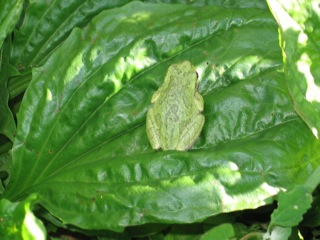

Anisoptera Acres Copyright © 2006
Contact us at farmerdan@anisopteraacres.com
Last updated September 24, 2016